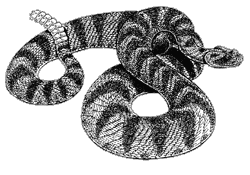Human Bites and Treatment
Rattlesnakes do not always rattle before they strike, nor must they coil before they strike. If they feel threatened, they may coil, strike, retreat or do nothing at all. Each snake is a unique individual and responds accordingly. In spite of the snakes’ lethal potential, fewer than 1 percent of the people bitten in the United States by venomous snakes die. Many bites to adult humans are the result of human provocation.
If you are bitten, remain calm and get to a hospital as soon as possible. Most first-aid treatments suggested many years ago are no longer recommended.
Important Note: Do not attempt to capture or kill the snake. In modern medical facilities, all rattlesnake bites receive the same antivenin.
Rattlesnake Rules
Here are a few simple rules that will help keep you from having an unexpected, and potentially dangerous, encounter with a rattlesnake.
- Identify everything before you pick it up.
- Don’t touch anything that can hurt you. If you don’t know if it can hurt you, don’t touch it.
- Always look under things before picking them up, and whenever
possible, before stepping on or around them.
- Look under things from a distance (use a tool to lift, then look).
- Always use a flashlight when you are out at night.
- Do not pick up a “dead”rattlesnake. It may not be dead, and even if it is, it may still bite (reflexively) and envenomate.
- Don’t walk barefoot or in open-toed shoes in the desert.
Guidelines for Removing a Rattlesnake from Your Yard or Home
Purpose
There are two reasons for attempting to remove (rather than kill) a rattlesnake from your property:
- Human or animal safety.
- Snake safety. Why? An injured snake is a dangerous one!
Mindset
To successfully remove a rattlesnake you need the right technique as well as the right mental and emotional state. You must remain calm when dealing with venomous animals. You must be in control of yourself to be in control of the animal.
Equipment
- Tongs
We recommend 42-inch tongs for dealing with a range of wild-caught animals. - Container
A specially designed, hinged, double-lidded wooden box, with a latching top is best. Single-lid boxes or large trash cans with secure lids can also be used. Be sure to check equipment periodically and immediately prior to use. You don’t want to find out that something is missing or broken when you need to capture an animal.
 |
Technique
- Be sure to have an escape route should you need it.
- Keep others away from the area (an assistant is very helpful for this).
- Approach the snake cautiously, preferably at an angle rather than head on.
- Maintain a safe distance. A snake may be able to strike a distance of up to two-thirds or more of its body length. If you stay more than one body length away you will be quite safe.
- Set up the container.
- Gently put the tongs around the animal. It is best to grasp the snake somewhere slightly before or at mid-body. Farther forward or backward risks injury to the snake and makes the creature more difficult to manipulate, which increases the risk to you.
- Gently apply enough pressure to slow or stop the animal from moving through the tongs. Too little pressure and the animal escapes, too much and it may be injured.
- Put the lid on the container without putting your fingers, or any other part of your body, on the underside of the lid or in a place where the animal can strike them.
- Secure the lid. You can use masking tape or bungee cords to secure a trash can lid.
- Relocate the animal, preferably a short distance from where it was captured, in an area where the snake doesn’t pose a threat to people or their pets.










